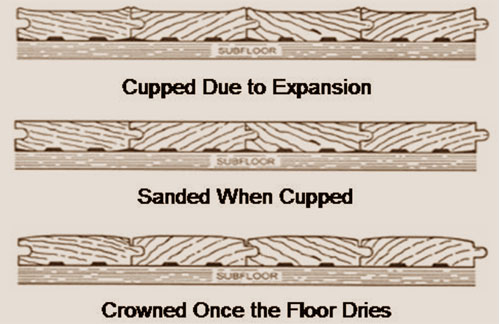Cupping and crowning are two terms used in the hardwood flooring industry to describe the reaction wood floors experience when there are problems with moisture levels in the home. It should be noted that very slight cupping or crowning can take place within normal humidity changes such as with those of the changing seasons and periodically should be expected. Solid wood flooring tends to be more susceptible to these problems as the wood planks are made of solid wood the entire way through, whereas engineered wood experiences less issues because only the top layers of the wood are made from the wood species in question. Both cupping and crowning can be experienced regardless of the wood species or width of the planks.
Cupping: Cupping happens when both side edges of the plank seem to rise up out of the floor and cause a “dip” to appear in the middle of the plank. It looks like a cup, a misshaped “U”. Cupping can be slight or very noticeable. When excess moisture is absorbed into the plank it causes the edges of the plank to expand with such force that they crowd the planks on either side of it, forcing the edges of the wood to rise up causing the dip in the middle. Usually this is because moisture remains underneath the planks.
Crowning: Crowning takes place when the edges of the wood shrink in towards the bottom while the middle or the top of the plank swells up past the rest of the regular level of the floor. It looks like a small roll sticking out above the rest of the flooring. This can either also be barely or very noticeable based on the situation. This happens when moisture is left sitting on top of the plank rather than the edges.
Probable Causes:
- Outside of normal changes in the humidity levels during seasonal changes, moisture can remain underneath the floor or on top of the planks without the homeowner necessarily being aware that it’s happening.
- A big spill could have taken place on the floor that was left unattended or not cleaned up after in a proper manner.
- Moisture could be leaking up through subflooring.
- A leaky pipe in the walls could be dripping down onto support beams that in turn lead to subflooring materials.
- Dryer vents can become clogged and then different moisture levels unknowingly get pumped back into the house. (It’s common for homeowners to be unaware this has been happening especially if the homeowner often turns the dryer on but then leaves the home and comes back several hours later.)
- Condensation near the bottom of uninsulated patio doors may accumulate near the edges of the floor.
- There may be a leaky faucet or pipe under the sink.
- A refrigerator or freezer may be not be working properly and leaking fluids slowly where the homeowner cannot see it.
- In locations that receive a lot of rain, rain run off may not be properly diverted away from the exterior of the home allowing moisture to seep in underneath the home and therefore potentially into subflooring.
- Slow leaks could exist in roofing or in overhead sprinkler systems.
Solutions:
Install a humidifier or dehumidifier in your home to help keep the humidity at constant levels. Be diligent about hardwood flooring installation preparation and make sure your home remains at a constant humidity level while the wood is being acclimated in your home before installation. Dryers can help speed up drying spots in the floor if need be. Once relatively constant humidity levels have been achieved in the home, have your flooring moisture tested to determine if any further action is necessary. Depending on the age or condition of the hardwood floor, the planks may need to be resanded and or recoated.

